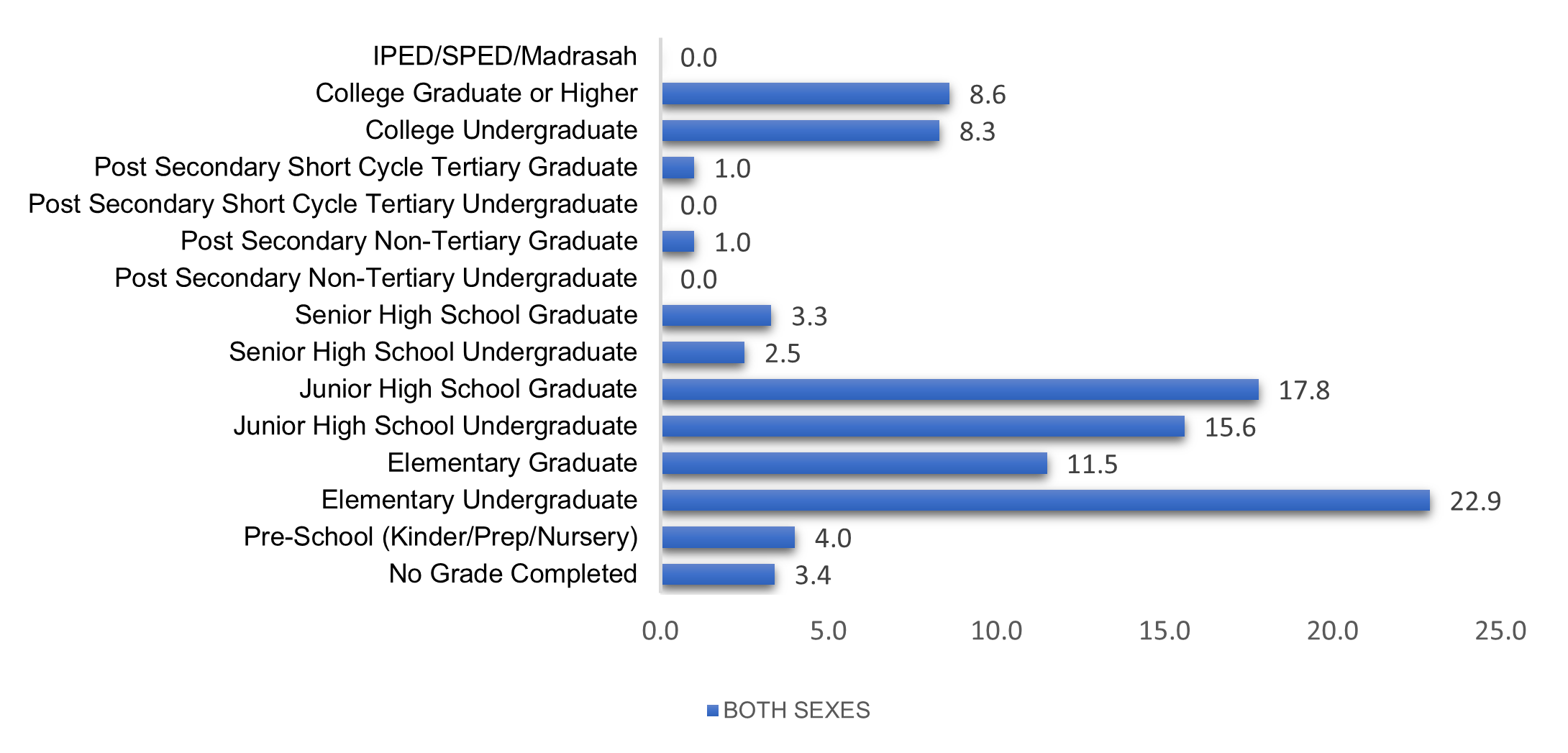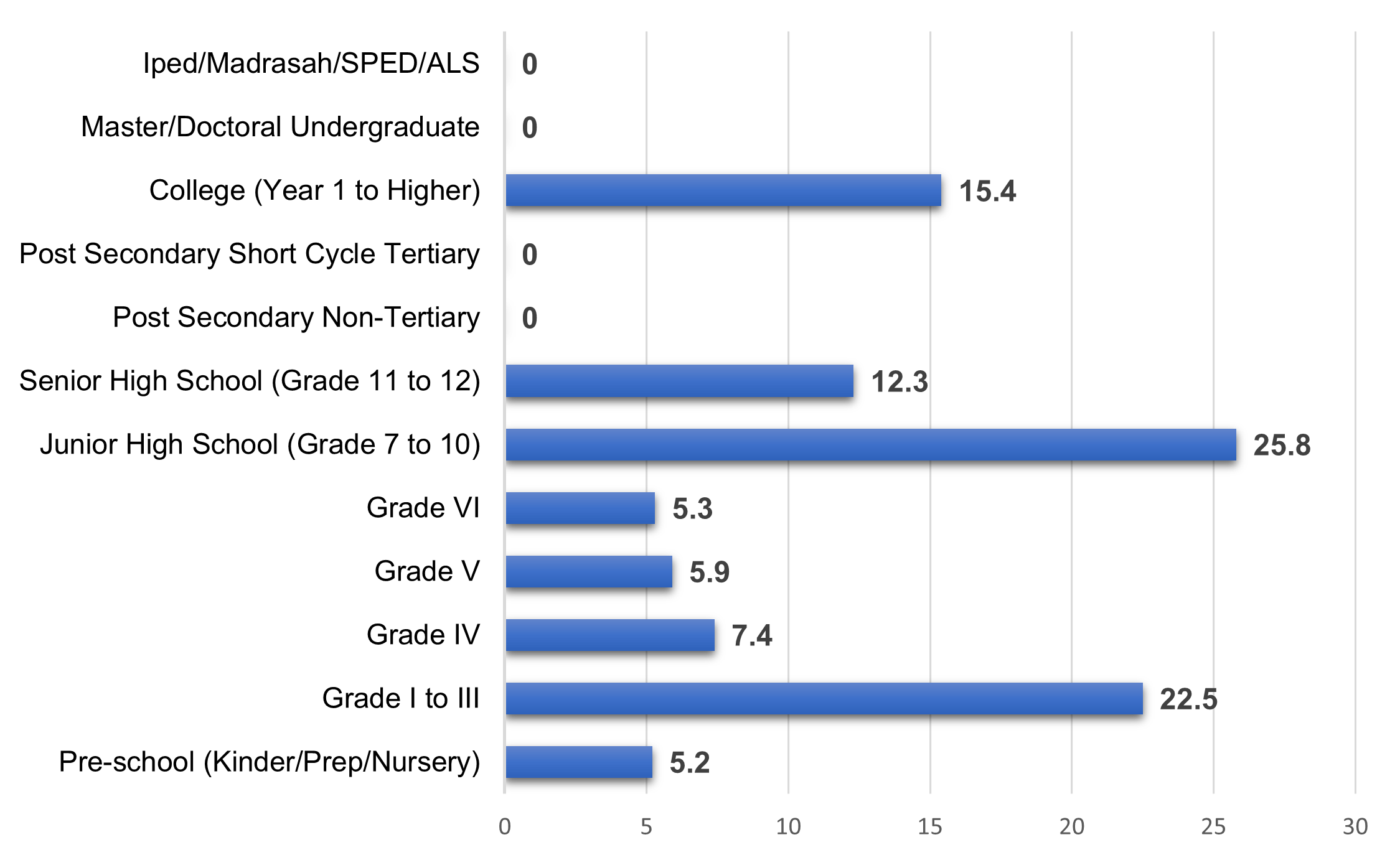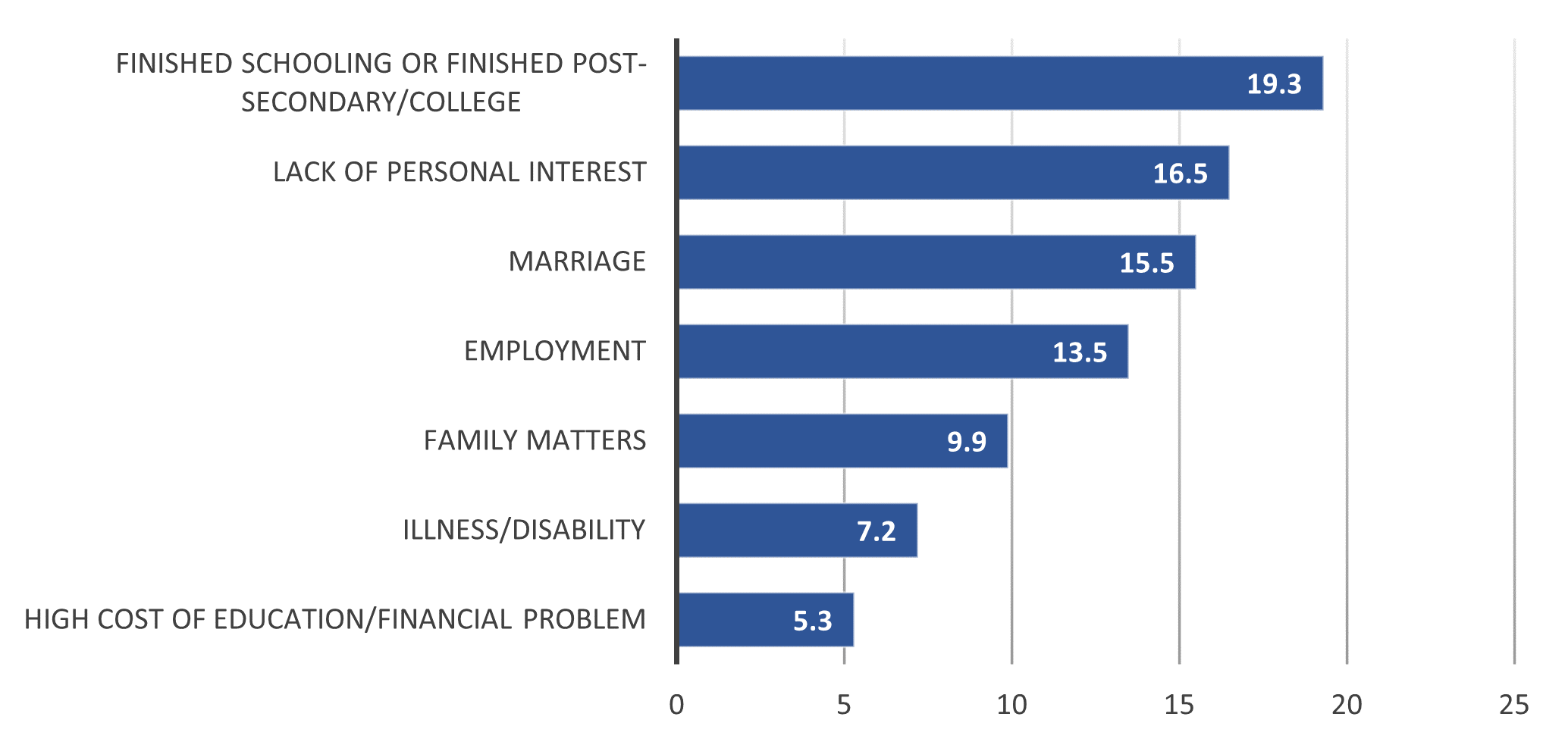Elementary Undergraduate shared the Highest percentage in Educational Attainment in MIMAROPA Region
In 2022, elementary undergraduate shared the highest percentage of population 22.9 percent followed by Junior High School Graduate with 17.8 percent shared. About 8.6 percent of the population aged five years and over had a college degree or higher in the region. Females tend to have higher completion of college degree or higher (11.0%) compared with males (6.4%). (Figure 1)
Figure 1. Percentage of Population Aged 5 Years and Over by Sex, Highest Grade/Year Completed, MIMAROPA: 2022

Source: Philippine Statistics Authority (PSA), 2022 Annual Poverty Indicators Survey
Eighty-five percent of Population in MIMAROPA Region were currently attending school
Out of 1.32 million aged 5 to 24 years over population in the region, 85.1 percent of the population were enrolled or attending school in 2022. By sex, there was a slightly higher proportion of males (42.6%) than females (42.5%) who were enrolled or currently attending school.
Meanwhile, among the population aged 5 to 24 years who were attending school, mostly were students aged 6 to 9 years with a share of 27.6 percent, followed by those aged 10-12 years and 17 to 19 years with 17.5 percent, and 14.3 percent share, respectively. (Figure 2)
Figure 2. Percentage of Population Aged 5 to 24 Years by Schooling Status, Age Group, MIMAROPA: 2022

Source: Philippine Statistics Authority (PSA), 2022 Annual Poverty Indicators Survey
In 2022, Junior High School (Grade 7 to 10) recorded the highest grade/year level whose population of aged 5 to 24 years were enrolled or attended school with 25.8 percent. Males tend to have the highest enrollment with 26.4 percent than females with 25.2 percent. (Figure 3)
Figure 3. Percentage of Population Aged 5 to 24 years Who Were Attending School by Sex, Current Grade/Year/Level Attending, MIMAROPA: 2022

Source: Philippine Statistics Authority (PSA), 2022 Annual Poverty Indicators Survey
Finished studying was the main reason for not attending school in MIMAROPA Region
In 2022, about 14.9 percent aged 5 to 24 years were not attending school. The top reasons mention were finished schooling of finished post-secondary or college (19.3%), lack of personal interest (16.5%), marriage (15.5%), employment (13.5%) and family matters (9.9%).
On the other hand, higher proportion of females were not attending school due to fished schooling with 28.4 percent. Apparently, higher proportion also of females were not attending school was due to marriage (23.2%). (Figure 4)
Figure 4. Percentage of Population Aged 5 to 24 years Who Were Not Attending School by Sex, Reason for Not Attending School, MIMAROPA: 2022

SourceSource: Philippine Statistics Authority (PSA), 2022 Annual Poverty Indicators Survey
Families with Children Aged 6 to 11 Years in Grade 1 to Grade 6
Based on the result of 2022 Annual Poverty Indicators Survey, of the 314 thousand families with children aged 6 to 11 years in MIMAROPA region, about 97.2 percent or 305 thousand families had children who were in Grade 1 to Grade 6. (Figure 5)
Figure 5. Percentage of Families with Children Aged 6 to 11 Years in
Grade 1 to 6

Families with Children Aged 12 to 15 Years in Junior High School Education
In 2022, of the 266,000 families with children aged 12 to 15 years old, about 90.1 percent or 240,000 had children who were in junior high school (Grade 7 to 10) in MIMAROPA Region. (Figure 6)
Figure 6. Percentage of Families with Children Aged 12 to 15 Years in Junior High School Education
(SGD) LENI R. RIOFLORIDO
Regional Director
OHG/EVC/MBC
Technical Notes
The Annual Poverty Indicators Survey (APIS) is a household-based survey to provide information on the different indicators related to poverty that can be used to monitor the poverty situation in the country. The APIS is undertaken during the years when the Family Income and Expenditure Survey (FIES) is not conducted. Moreover, APIS is a rider survey to the July Labor Force Survey (LFS) round.
The 2022 APIS is the fourteenth in a series of poverty indicators survey conducted nationwide since 1998. The APIS is designed to provide estimates for non-income indicators related to poverty and serve as inputs in the Multi-dimensional Poverty Index (MPI) development.
Specifically, it gathers information on indicators that are correlated with poverty in order to determine the percent distribution of families in relation to the following indicators:
a. owner-like possession of house and lot and type of materials for the roof, outer walls, and floor materials of the housing unit;
b. type of toilet and handwashing facility, main source of water supply, and source of drinking water used by the family;
c. ownership of household conveniences;
d. children 6-11 years old enrolled in Grade 1 to Grade 6;
e. children 12-17 years old enrolled in junior high school (Grade 7 to Grade 10);
f. who availed loan/s and its sources;
g. who received and availed selected social protection programs; and
h. access to government services.
The 2022 APIS had a national sample of approximately 44,000 sample households deemed sufficient to provide reliable estimates at the national and regional levels. These sample housing units/households are selected from the 2013 Master Sample (MS) for household-based surveys of the PSA.
The reporting unit is the household, which means that the statistics emanating from this survey will refer to the characteristics of the population residing in private households. Persons who reside in the institutions are not within the scope of the survey.
The data collection of the 2022 APIS ran for 21 days from 08 to 30 July 2022. In this round of the APIS, Computer Aided Personal Interviewing (CAPI) using Tablet devices was utilized during data collection. The statistical researchers visited the sample housing units and interviewed the eligible respondents. The eligible respondent is the household head or the spouse of the head. In the absence of the household head or of his/her spouse, the respondent can be any responsible adult member who can provide reliable answers to questions asked by the survey interviewer about the household and its members.
The 2022 APIS, being a household-based survey, used the 2013 Master Sample (MS) of which 4 replicates equivalent to a total of 42,768 Secondary Sampling Units (SSUs) or sample housing units were selected as samples. Using a two-stage cluster sampling design, Enumeration Areas (EAs)/barangays were selected at the initial sampling stage as the Primary Sampling Units (PSUs), while the housing units within the selected PSUs were selected as the SSUs. Generally, all households within the sample housing unit were also considered as sample households. However, for housing units with more than three (3) households, a maximum of three (3) sample households were randomly selected.

